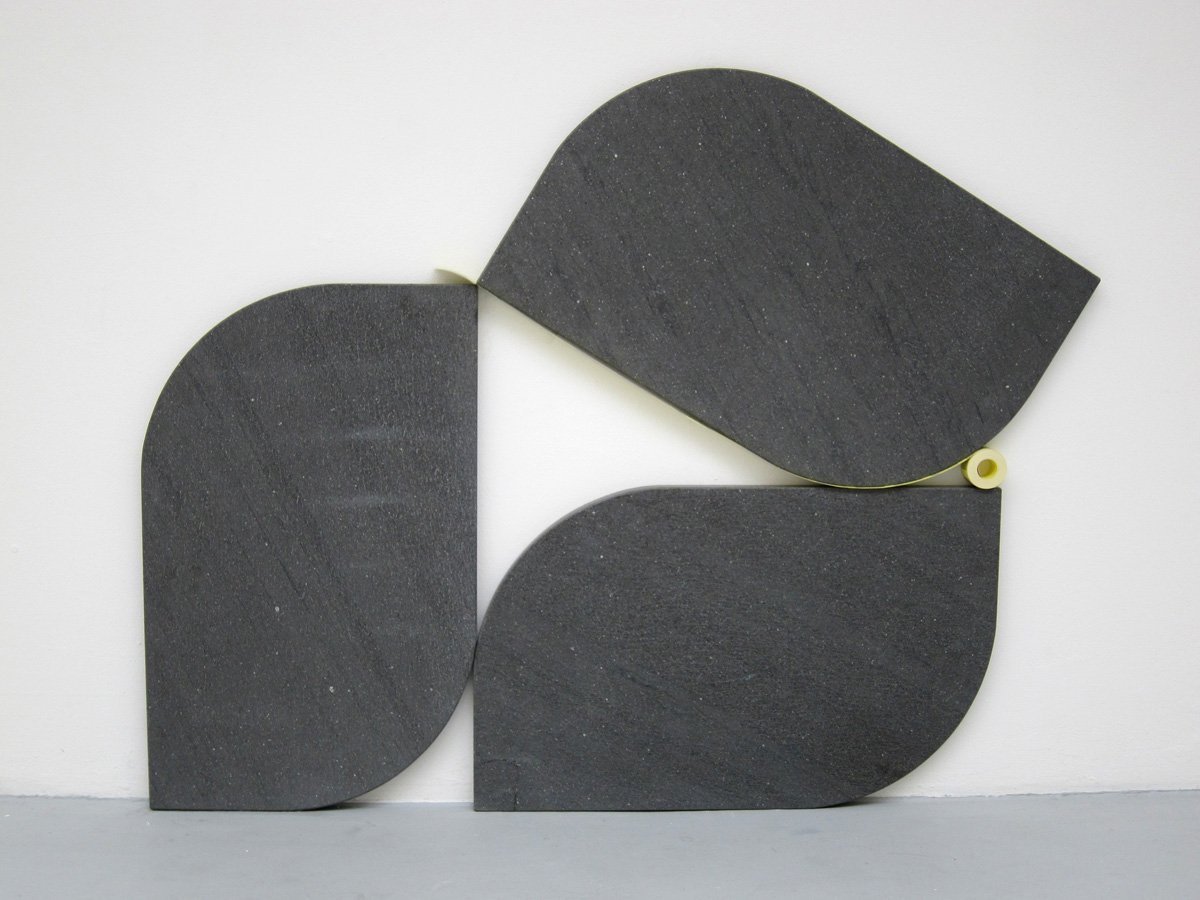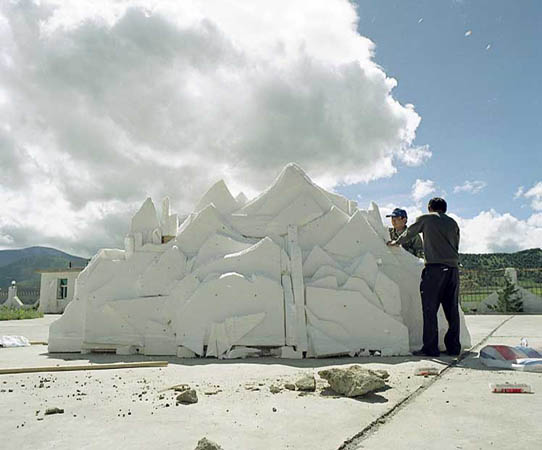
© » KADIST
Choi Jeong-Hwa
The application of bright colors and kitsch materials in Flower Tree manifests a playful comment on the influence of popular culture and urban lifestyle. And though his works share a similar sensibility to Claes Oldenburg’s oversized sculptures from everyday objects, Choi draws from his immediate surroundings and life experience. Public sculptures with a flower theme are often used to decorate the rapidly urbanized cities in Asia, which are constructed with concrete and steel materials.

© » KADIST
Gareth Moore
Uncertain Pilgrimage is an ongoing project in which Moore draws from his unplanned travels in recent years. Many of the pieces are found objects and discarded materials that he has transformed into tools and eccentric prop-like sculptures to help him on his journeys. Map (from Uncertain Pilgrimage) is one such object that could be a metaphor for the whole project: a simple empty paper map that has no location written on it.

© » KADIST
Bjorn Copeland
Sign #1 , Sign #2 , Sign #3 were included in “Found Object Assembly”, Copeland’s 2009 solo show at Jack Hanley Gallery, San Francisco. These rather austere collages were created by simply cutting and inverting the text from existing information signs. In Sign #2 , for example, the original image that presumably carried the message “NO RIDERS” was placed upside down.

© » KADIST
Wong Wai Yin
Drawn from the widely circulated images of protests around the world in support of women rights and racial equality, the phrase I can’t believe we are still protesting is both the title of Wong Wai Yin’s photographic series and a reference to similar messages seen on protest signages. The artist used found images from the internet, including a viral photo of an elderly woman who took part in the 2016 “Black Monday” strike against a proposed anti-abortion law in Poland, and another image taken the same year of a group of protestors in the United Kingdom, rallying for the Black Lives Matter movement. Drawing parallels with Hank Willis Thomas’s I Am a Man (2013) painting in the KADIST Collection, Wong employs the visual language and terminology of mass media, specifically borrowing images from protests on civil rights issues.

© » KADIST
Wong Wai Yin
In this work the artist stages a humorously violent “intervention” against male-dominated cultures of art production in present-day China. For this video, Wong accompanied six male friends from art school to a group show of their work titled “Inside Looking Out” at Osage Gallery in Beijing. Throughout her visit, she was rarely acknowledged for her own creative accomplishments and was more frequently introduced as an artist’s girlfriend, and often without name.

© » KADIST
Wong Wai Yin
Drawn from the widely circulated images of protests around the world in support of women rights and racial equality, the phrase I can’t believe we are still protesting is both the title of Wong Wai Yin’s photographic series and a reference to similar messages seen on protest signages. The artist used found images from the internet, including a viral photo of an elderly woman who took part in the 2016 “Black Monday” strike against a proposed anti-abortion law in Poland, and another image taken the same year of a group of protestors in the United Kingdom, rallying for the Black Lives Matter movement. Drawing parallels with Hank Willis Thomas’s I Am a Man (2013) painting in the KADIST Collection, Wong employs the visual language and terminology of mass media, specifically borrowing images from protests on civil rights issues.

© » KADIST
Wong Wai Yin
Drawn from the widely circulated images of protests around the world in support of women rights and racial equality, the phrase I can’t believe we are still protesting is both the title of Wong Wai Yin’s photographic series and a reference to similar messages seen on protest signages. The artist used found images from the internet, including a viral photo of an elderly woman who took part in the 2016 “Black Monday” strike against a proposed anti-abortion law in Poland, and another image taken the same year of a group of protestors in the United Kingdom, rallying for the Black Lives Matter movement. Drawing parallels with Hank Willis Thomas’s I Am a Man (2013) painting in the KADIST Collection, Wong employs the visual language and terminology of mass media, specifically borrowing images from protests on civil rights issues.

© » KADIST
Wong Wai Yin
Drawn from the widely circulated images of protests around the world in support of women rights and racial equality, the phrase I can’t believe we are still protesting is both the title of Wong Wai Yin’s photographic series and a reference to similar messages seen on protest signages. The artist used found images from the internet, including a viral photo of an elderly woman who took part in the 2016 “Black Monday” strike against a proposed anti-abortion law in Poland, and another image taken the same year of a group of protestors in the United Kingdom, rallying for the Black Lives Matter movement. Drawing parallels with Hank Willis Thomas’s I Am a Man (2013) painting in the KADIST Collection, Wong employs the visual language and terminology of mass media, specifically borrowing images from protests on civil rights issues.

© » KADIST
Qiu Anxiong
A Portrait: Covering and Cleaning is an installation of six black-and-white video projections. Each video depicts a portrait with features changing continuously and quickly into different persons, animals and symbols. Driven by the evolving contents of the screen itself, this piece showcases the form and material of Qiu Anxiong’s working method, which relies on precisely planned storyboard sketches drawn in pen on A4 paper.

© » KADIST
Gabriel Kuri
Gabriel Kuri has created a series of works in which he juxtaposes perennial and ephemeral materials. Untitled (Ticket Roll) belongs to this group of sculptures and consists of three smooth ornate marble elements and a roll of public transport tickets. The artist poetically associates finesse and fragility as in a number of these works.

© » KADIST
Li Liao
A Slap in Wuhan documents Li Liao’s performance in Wuhan, China on January 8, 2011. Li waits at the entrance of the Optical Valley walking street. An anonymous person who was recruited online approaches Li and slaps him in the face.

© » KADIST
Patty Chang
The video “Shangri-La” refers to the mythical city of James Hilton’s novel “Lost Horizon” written in 1933 and is exemplified in a film by Frank Capra which speaks of eternal youth in a city of happiness. In 1997, a small town in an agricultural region of central China near the Tibetan border was proclaimed as the place that inspired Shangri-la. Thereafter, a dozen other cities in the same area have claimed to be paradise on earth, prompting a marketing battle without mercy, raging on until the government’s intervention.

© » KADIST
Cildo Meireles
Meireles, whose work often involves sound, refers to Sal Sem Carne (Salt Without Meat) as a “sound sculpture.” The printed images and sounds recorded on this vinyl record and it’s lithographed sleeve describe the massacre of the Krahó people of Brazil. The piece draws on Meireles’s first-hand contact with many indigenous groups through his father’s work with the Indian Protection Service. The recordings on the LP contain narrative accounts of massacres of native peoples, as well as indigenous music and rituals.
Wong Wai Yin
Wong Wai Yin is an interdisciplinary artist who experiments with a variety of media ranging from painting, sculpture, collage, performance, video, installations and photography...
Qiu Anxiong
- location: Shanghai, China
- year born: 1972
- gender: male
- nationality: Chinese
- home town: Chengdu, Sichuan Province, China
Bjorn Copeland
- location: New York, New York
- gender: male
Cildo Meireles
- location: Rio de Janeiro, Brazil
- year born: 1948
- gender: male
- nationality: Brazilian
- home town: Rio de Janeiro, Brazil
Li Liao
- location: Shenzhen, China
- year born: 1982
- gender: male
- nationality: Chinese
- home town: Hubei Province, China
Choi Jeong-Hwa
- year born: 1961
- gender: male
- nationality: Korean
- home town: Seoul, South Korea
Patty Chang
- location: New York, New York
- year born: 1972
- gender: female
- nationality: American
- home town: San Francisco, California
Gareth Moore
- location: Berlin, Germany
- year born: 1975
- gender: male
- nationality: Canadian
- home town: Matsqui, Canada
Gabriel Kuri
- location: Mexico City; Brussels, Belgium
- year born: 1970
- gender: male
- nationality: Mexican
- home town: Mexico City, Mexico
-
1970-1979
Cildo Meireles
1975Meireles, whose work often involves sound, refers to Sal Sem Carne (Salt Without Meat) as a “sound sculpture.” The printed images and sounds recorded on this vinyl record and it’s lithographed sleeve describe the massacre of the Krahó people of Brazil...
-
2000-2009
Gareth Moore
2006Uncertain Pilgrimage is an ongoing project in which Moore draws from his unplanned travels in recent years...
Choi Jeong-Hwa
2008The application of bright colors and kitsch materials in Flower Tree manifests a playful comment on the influence of popular culture and urban lifestyle...
Wong Wai Yin
2008In this work the artist stages a humorously violent “intervention” against male-dominated cultures of art production in present-day China...
Bjorn Copeland
2009Sign #1 , Sign #2 , Sign #3 were included in “Found Object Assembly”, Copeland’s 2009 solo show at Jack Hanley Gallery, San Francisco...
-
2010-2019
Gabriel Kuri
2010Gabriel Kuri has created a series of works in which he juxtaposes perennial and ephemeral materials...
Qiu Anxiong
2011A Portrait: Covering and Cleaning is an installation of six black-and-white video projections...
-
2020-2029
Wong Wai Yin
2021Drawn from the widely circulated images of protests around the world in support of women rights and racial equality, the phrase I can’t believe we are still protesting is both the title of Wong Wai Yin’s photographic series and a reference to similar messages seen on protest signages...
Wong Wai Yin
2021Drawn from the widely circulated images of protests around the world in support of women rights and racial equality, the phrase I can’t believe we are still protesting is both the title of Wong Wai Yin’s photographic series and a reference to similar messages seen on protest signages...
Wong Wai Yin
2021Drawn from the widely circulated images of protests around the world in support of women rights and racial equality, the phrase I can’t believe we are still protesting is both the title of Wong Wai Yin’s photographic series and a reference to similar messages seen on protest signages...
Wong Wai Yin
2021Drawn from the widely circulated images of protests around the world in support of women rights and racial equality, the phrase I can’t believe we are still protesting is both the title of Wong Wai Yin’s photographic series and a reference to similar messages seen on protest signages...
